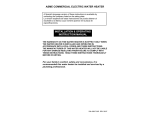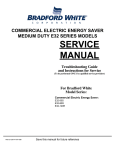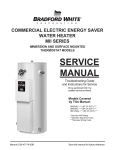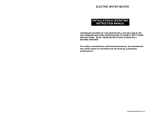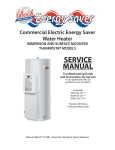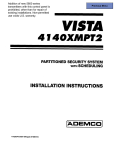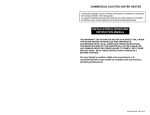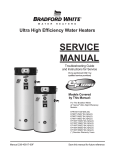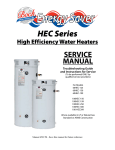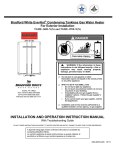Download Bradford White 30A Service manual
Transcript
COMMERCIAL ELECTRIC ENERGY SAVER WATER HEATER ASME SERIES IMMERSION THERMOSTAT WITH CONTACTORS SERVICE MANUAL Troubleshooting Guide and Instructions for Service (To be performed ONLY by qualified service providers) Models Covered by This Manual: 6A, 12A, 20A, 30A, 40A, 50A, 80A, 120A Manual 238-47202-00A Save this manual for future reference ASME Series Commercial Electric Water Heaters Table of Contents Page Service Procedure Introduction ………………………………………………………………………. 2 --- Tools……………………………………………………………………………… 2 --- General Information ……………………………………………………………… 3 --- Sequence of Operation …………………………………………………………… 10 --- Troubleshooting ………………………………………………………………….. 13 --- Heating Element Testing ……………..................................................................... 15 ACE-I Line Voltage Testing………………...…………………………………………… 16 ACE-II Fuse Testing…......................................................................................................... 17 ACE-III High Limit (ECO) Testing……………………………………………………..…. 18 ACE-IV Immersion Thermostat Operation Testing………................................................... 19 ACE-V Contactor Operation Testing……………………………………………………… 20 ACE-VI Immersion Thermostat Removal and Replacement…………….………………… 21 ACE-VII High Limit (ECO) Removal and Replacement……………..…………………….. 22 ACE-VIII Heating Element Removal and Replacement …………………………………….. 23 ACE-IX Anode Inspection and Replacement ……………………………………………… 24 ACE-X Generic Parts List ………………………………………………………………… 25 --- Glossary of Terms…………………………………………………………………. 26 --- Introduction This service manual is designed to aid service and maintenance professionals on the function, proper diagnosis and repair of Bradford White Commercial Electric Water Heaters. The text and illustrations in this manual provide step by step instructions to facilitate proper operation and troubleshooting procedures. Contact the Bradford White Technical Support Group immediately if diagnosis can not be made using the methods described in this service manual. Tools - Multi Meter. - 2-1/8" Deep Well Socket. - 1-1/16" Deep Well Socket. - ¼" Nut Driver. - Phillips Head Screw Driver. - Common Screw driver. - Thermometer. - Drain Hose. - Other Hand Tools: Pipe Wrench, Channel Locks, Pliers (common & needle nose), Wire cutters, Wire Strippers, Allen Wrench Set, Flash Light. Page 2 2 GENERAL INFORMATION Model Number Breakdown 120A - 24 - 3 - 108B - BBG Pressure Gage Option. Control Circuit Option Code. Any combination of the following optional controls: - Heating Element Time Delay Sequencing. - Low Water Power Interrupt. - Panel Door Interlock - High Pressure Power Interrupt - Low Pressure Power Interrupt - Alarm Horn NOTE: Code “AA” denotes no optional controls used. Power Circuit Code. - Voltage - kW Rating - Phase - Amp Rating Warranty In the Field, this information is obtained from the heaters rating plate kW Rating Tank Model Number Electrical Characteristics BRADFORD WHITE CORPORATION 200 LAFAYETTE ST. MIDDLEVILLE MI 49333 Model No: 120A-24-3-108B-BBG Serial No: ZB2564812 Cap. 120(gal.)/454.2(liters) Press: Test 300(psi), Working 150(psi) Volts 240 Max Temp 180° Phase Single Amps 100 kW Each 6 Total kW 24 Wattage Rating Based Upon 60 Hz 4 Elements Typical Rating Plate Located On Front Of Water Heater Page 3 3 GENERAL INFORMATION General Controls Layout Control Circuit Fuse Block Control Circuit Transformer Terminal strip Pressure Gage (optional) Terminal Block Power Circuit Fuse Blocks Thermostat Control Contactors Heating Element Time Delay Sequencers (optional) Low Water Level Control (optional) High Pressure Limit Switch (optional) Low Pressure Limit Switch (optional) High Limit Immersion Bulb Thermostat Immersion Bulb High Limit (ECO) Alarm Horn Relay (optional) Alarm Horn (optional) Heating Element Standard Controls Contactor Contactor operation is achieved by energizing a 120 volt operating coil located within the contactor in response to a call for heat from the immersion thermostat. Upon a call for heat, one or more contactors will energize all heating elements simultaneously. Optionally, time delay sequencers may be used to stage contactor activation thereby reducing the inrush of current to the water heater. Terminal connections of contactor operating coil. Terminal connections to the fuse block and/or terminal block Terminal connections to the heating elements Page 4 4 GENERAL INFORMATION Standard Controls (continued) Immersion Style Thermostat Control The thermostat will complete control circuit voltage upon a call for heat. Likewise, the control will interrupt control circuit voltage when the water temperature is sufficient to satisfy the adjustable temperature limit of control. Immersion Thermostat Control Direct Immersion bulb Immersion Style High Limit (ECO) Control for Contactor Models The high limit (ECO) control will interrupt control circuit voltage causing the heater to shut down when the high temperature limit of the control is reached (196°F±4°F). Once the cause for over heated water has been determined, The control must be manually reset to restore normal operation. Manual Reset Buttons Direct Immersion bulb Page 5 5 GENERAL INFORMATION Standard Controls (continued) Direct Immersion “Screw-in” Type Heating Element 2-1/8 Hex Screw-in Flange Terminal Block Screw Terminal Block Zinc Plated Copper or Incoloy Sheath Element Rating Ink Stamped on face of Terminal Block. Optional Controls Certain control components are available as “Optional“. When these optional components are installed with the water heater, the control circuit wiring diagram accordingly will include these components. The optional equipment available from the manufacturer includes the following: -High Water Pressure Switch -Heating Element Time Delay Sequencers -Low Water Pressure Switch -Electrical Door Lock -Low Water Level Switch -Alarm Horn High and Low Water Pressure Controls- These controls interrupt the electrical current to the contactor coil when the pressure settings are exceeded. The operation and setting of these controls are described in the manual provided by the control manufacturer. This manual is included with the water heater Installation and Operating Instruction manual provided with the water heater. The pressure settings for these controls are adjustable. These controls are specified for use when the installation has unique pressure requirements that must be safeguarded. Therefore, before adjusting the pressure values, it is recommended that you consult the person responsible for the facility that the water heater is servicing. The electrical connections are referenced in the Control Circuit Wiring Diagram and in the pressure control manual provided by the control manufacturer. Refer to these instructions when servicing the controls. Page 6 6 GENERAL INFORMATION Optional Controls (continued) Low Water Level Control- This control will interrupt the electrical current to the contactor coil when a low water level condition is sensed inside the water heater tank. When the low water level condition is corrected the control will automatically sense the new situation and electrical current will again energize the contactor coil. Normal water heater operation will be resumed. To remove the low water level control from the tank you must first loosen the control by un-threading it from the tank fitting and then rotating the control until the arrow printed on the side of the hex fitting is pointing downward. This will enable the float orientation to align itself with the opening in the tank-fitting. When installed, refer to the direction of the arrow on the hex and insure that it is pointing upwards. If it is not pointing upward, the control switch will not activate when the tank is refilled with water. Refer to illustration below for clarification. Heating Element Time Delay Sequencers- Heating element sequencers are available in order to stage the activation of the heating elements thereby, reducing the inrush of electrical current to the water heater. The sequencers will control one or more contactor coils depending upon the water heater voltage, phase, and KW. One contactor will be energized immediately when there is heating demand, the second contactor, controlled with a sequencer, will be activated approximately 20 seconds later, and the third contactor will be activated in another 20 seconds thereby, staging the three contactors over the 40 second time period. The staging occurs in a similar manner for applications having more than three contactors. Refer to the Control Circuit Wiring Diagram for the specific application being serviced. Note: On the occasion of servicing the water heater where frequent restarts in a short time interval are encountered (i.e. on, off, on, etc.), the timing sequences will not begin until the sequencers have experienced a time interval to reset. Page 7 7 GENERAL INFORMATION Optional Controls (continued) Electrical Door lock- An electrical door lock is offered in order to secure the access to the water heater control cabinet. This device will lock the control cabinet door when the 120VAC control circuit voltage is applied to it. Note: Once the door is opened, the water heater can be re-energized, if necessary, for service diagnosis. Alarm HornThe Alarm Horn is an option specified when the installation desires an audible signal to immediately sound an alert when the water heater operation is interrupted for certain faults. Referring to the control circuit wiring diagram, the alarm will activate when any one of the following events occur: The Hi-Limit control has been tripped The High Water Pressure Control senses excessive pressure The Low Water Pressure Control senses insufficient pressure The Low Water Level Control senses an insufficient quantity of water The alarm will sound only for the options specified (i.e. if a low water level control is not specified then the alarm will not recognize a low water level condition). Horn Relay Internal Wiring Horn Relay Combination Temperature and Pressure GageA non-electrical device to visually reference water temperature and internal tank pressure. Page 8 8 GENERAL INFORMATION Commonly Used Formulas (balanced 3 phase) (Single phase) Watts Amps = Amps = Volts Common Service Wire Configurations Watts Ohms = Watts = Amps x Volts Volts x 1.732 2 Volts Watts 240V 1Ph BLACK Ungrounded GREEN Grounding RED Ungrounded 240 120 120 208 3Ph Neutral A 480 3Ph/277 1Ph 240 3Ph B C Neutral A B C Neutral 120 120 120 208 120 208 240 208 240 RED RED C 277 120 BLACK B 277 120 RED A 480 277 480 240 BLACK RED RED 480 BLACK RED Full Load Current Amps 240 Volt 600 Volt 277 Volt 380 Volt 415 Volt kW 1 Ph 3 Ph 1 Ph 3 Ph 1 Ph 3 Ph 3 Ph 1 Ph 3 Ph 3 14.4 - 12.5 - 10.8 - - 6.3 - - 6 28.8 16.6 25.0 14.4 21.6 9.1 8.3 12.5 7.2 5.7 9 12 43.2 57.6 25.0 33.3 37.2 50.0 21.6 28.9 32.4 43.3 13.6 18.2 12.5 16.7 18.7 25.0 10.8 14.4 8.66 11.5 13.5 64.9 37.5 56.2 32.5 48.7 20.5 18.8 28.1 16.2 13.0 15 72.1 41.6 62.5 36.1 54.1 22.7 20.9 31.2 18.0 14.4 18 86.5 50.0 75.0 43.4 64.9 27.3 25.0 37.5 21.6 17.3 24 115.4 66.7 100.0 57.8 86.6 36.4 33.4 50.0 28.9 23.1 27 129.8 75.0 112.5 65.0 97.4 41.0 37.5 56.2 32.5 26.0 30 144.2 83.3 125.0 72.2 108.3 45.6 41.7 62.5 36.1 28.8 36 173.0 100.0 150.0 86.7 129.9 54.7 50.1 75.0 43.3 34.6 45 54 216.3 259.6 125.0 150.0 187.5 225.0 108.3 130.0 162.4 194.9 68.4 82.0 62.6 75.1 93.7 112.5 54.1 65.0 43.3 52.0 81 389.4 224.8 337.5 194.8 292.4 123.1 112.6 168.7 97.4 78.0 208 Volt 480 Volt 3 Ph Page 9 9 SEQUENCE OF OPERATION This water heater has two distinct electrical systems. One system, referred to as the “Control Circuit”, controls the water heater operation, while the other system referred to as the “Power Circuit”, connects the electrical power to the heating elements, The electrical contactors interconnect these two systems. In order to clearly illustrate the electrical circuits, two wiring diagrams are provided. These diagrams are labeled as the “Control Circuit Wiring Diagram” and the “Power Circuit Wiring Diagram” and they are attached to the surface of the panels inside the water heater control cabinet. Control Circuit Description- The control circuit operates with 120VAC electrical service. This voltage is provide by the multi-tap transformer which has the primary coil connected to the field wiring that is serving the water heater. The Transformer, Thermostat, Hi-Limit control, and the Contactor Coil are always included in the Control Circuit. Certain other control components are available as “Optional“. When these optional components are installed with the water heater, the control circuit wiring diagram accordingly will include these components. The optional equipment available from the manufacturer includes the following: High Water Pressure Switch Low Water Pressure Switch Low Water Level Switch Line voltage from power circuit Alarm Horn Heating Element Sequencers Electrical Door Lock Appropriate line voltage multi-tap terminal Control Circuit Sequence of OperationNOTE: To help understand the concept of the operating sequence, the control circuit shown is without any optional controls. See page 11 For control circuit showing all available optional controls 1 Line voltage is applied to control circuit fuse block. 2 Line voltage continues to transformer with one leg of voltage connecting to the common terminal and the other leg connecting to the appropriate line voltage multi-tap terminal. Transformer output (always 120 volts) continues to high limit (ECO) control. 3 4 5 6 Hi limit (ECO) control is closed so one leg of 120 volts continues to one side of the contactor coil. The other leg is connected to the thermostat. When the thermostat calls for heat, contacts close inside the thermostat completing the circuit and energizing the contactor coil. Control Circuit Wire Diagram The energized contactor coil causes the contactor to close energizing the heating elements. When the temperature setting of the thermostat is reached, the contacts in the thermostat open. This interrupts current flow through the control circuit deenergizing the contactor coil. 7 Page 10 10 The de-energized contactor coil causes the contactor to open, interrupting current flow through the Heating elements. SEQUENCE OF OPERATION Control Circuit Sequence (Continued)- Certain other control components are available as “Optional“. These controls are specified when the installation has unique requirements that must be safeguarded. When these optional components are installed the control circuit wiring diagram accordingly will include these components. The optional equipment available from the manufacturer includes the following: High Water Pressure Switch Low Water Pressure Switch Low Water Level Switch Alarm Horn Line voltage from power circuit Heating Element Sequencers Electrical Door Lock Appropriate line voltage multi-tap terminal Control Circuit Sequence of Operation with Optional ControlsSame as explained on page 10 with the following exceptions: -Hi and Low Pressure Switch and Low Water Level Switch when specified are always wired in series ahead of the Hi-limit control. -Heating Element Sequencers are wired in series with contactor coils staging contactor activation at intervals of approximately 20 seconds. -Alarm Horn is wired in series ahead of the thermostat. It monitors only the Hi and Low pressure switch, Low water level Switch and the hi-limit (ECO). If either of these switches open, power to the horn relay is interrupted causing the relay to close sounding the alarm horn. -Electrical Door Lock is wired in parallel to secure the access to the water heater control cabinet. This device will lock the control cabinet door when the 120VAC control circuit voltage is applied. Once the door is opened, the water heater can be re-energized, if necessary, for service diagnosis. Control Circuit Wire Diagram Showing Optional Controls Page 11 11 SEQUENCE OF OPERATION Power Circuit Description- The Power Circuit Wiring Diagram illustrates the electrical connections from the incoming power supply through the contactors to the heating elements. The power circuits are available with internal circuit fusing and without internal circuit fusing. As it would be impractical to show all wired configurations in this service manual, a reference wiring diagram is illustrated below to aid in the understanding of the power circuit operating sequence. Service providers must refer to the water heaters power circuit wiring diagram attached to the inside panel of the control cabinet for the specific connections of the water heater being serviced. The power circuit components and supporting information that appear on the wiring diagram include the following: Field wiring connection via terminal block or other connection point Fuse block with amperage ratings displayed (when provided) Line voltage from service panel Contactors with amperage ratings displayed Electrical elements with voltage and wattage ratings displayed Water heaters total amperage draw is displayed Line voltage to control circuit Power Circuit Sequence1 Line voltage is applied across terminals of fuse block or a terminal block. Line voltage continues down and connects to terminals L1, L2 & L3 of one or more contactors. A) Contactor is open (no call for heat), so there is no voltage across terminal T1, T2 & T3 of contactor. B) The contactor is controlled by the control circuit as explained on pages 10 & 11. 2 3 4 5 The control circuit senses a call for heat and energizes the operating coil within the contactor. The energized contactor coil causes the contactor to close energizing the elements from terminals T1, T2 & T3 of the contactor. When the temperature setting of the thermostat is reached, the contacts in the thermostat open. This interrupts current flow through the control circuit deenergizing the contactor coil. The de-energized contactor coil causes the contactor to open, interrupting current flow through the elements. Page 12 12 TROUBLESHOOTING Most common cause for improper electric water heater operation can be linked to heating element failure. When troubleshooting an electric water heater with the incidence of “No Hot Water” or “Insufficient Amount of Hot Water” It is always a good idea to check the heating elements first following the procedure on page 15. Common Heating Element Failures Are: 1. Dry Firing. Elements may be partially submerged in water or most likely, completely exposed with no water in the tank at all. In open air, an energized element (Dry Fired) will become completely inoperable within seconds. In some cases sediment or lime build up around an element can eventually cause an air pocket, resulting in a dry fired element. When element replacement is required, be sure tank is full of water prior to energizing the water heater. 2. Grounded Element. In most cases, an element with a short circuit to ground will cause the circuit breaker in the service panel to open or shut off. In some cases there may not be enough current draw for the circuit breaker to open. This will allow the heating element to be in continuous operation resulting in over heated water, limited only by the hi-limit (ECO) located in the control circuit. Repeated actuation of the hi-limit usually is the result of a grounded heating element. 3. Sediment build up. Slow hot water recovery can usually be traced back to sediment or lime build up around heating element. Sediment build up can also over time cause a dry fired element. If an heating element is found to be inoperative, it must be replaced. Follow service procedure ACE-IX on page 23. The illustration below shows a common “Screw-In” type heating element identifying certain features commonly referred to throughout this manual. 2-1/8 Hex Screw-in Flange Terminal Block Screw Terminal Block Zinc Plated Copper or Incoloy Sheath Element Rating Ink Stamped on face of Terminal Block. Typical Direct Immersion “Screw-In” Type Heating Element Page 13 13 TROUBLESHOOTING Quick Step Plan to Hot Water WARNING High voltage exposure. Use caution when making voltage checks to avoid hazard to life or property. 1. STOP, DANGER! Turn power “OFF” to water heater. 2. Check all wire connections to insure they are snug and corrosion free. 3. Reset high limit (ECO) (page 18). 4. Check for inoperative heating element (page 15). 5. Check line voltage (pg 16), and internal fuses (page 17). 6. Refer to table below if items 1 through 5 above do not correct problem. SYMPTOM PROBABLE CAUSE 1. No power to heater. 2. Blown water heater fuses. 3. Loose wire connections. 4. Inoperative heating element(s). 5. Inoperative thermostat. 6. Open ECO. 7. Inoperative contactor(s). 1. 2. 3. 4. 5. 6. 7. Check circuit breakers at service panel. Check water heater fuses. Check all wire connections. Check heating element(s). Check thermostat operation. Reset (check) ECO. Check contactor operation. 2. 4. 5. 6. 7. Not Enough Hot Water 1. Inoperative heating element(s). 2. Thermostat set to low. 3. Inoperative thermostat. 4. Inoperative contactor(s). 5. Loose wire connection. 6. High demand period. 7. Undersized heater. 8. Very cold inlet water to heater. 9. Plumbing connections reversed. 1. 2. 3. 4. 5. 6. 7. 8. 9. Check heating element(s). Increase thermostat setting. Check thermostat. Check contactor operation. Check all wire connection. Reduce demand. Replace with larger heater. Temper water to heater. Correct plumbing connections. 1. ACE-I, Page 15. 3. ACE-V, Page 19. 4. ACE-VI, Page 20. Slow Hot Water Recovery 1. Sediment or lime build up on element(s). 2. Loose wire connections. 3. Inoperative contactor(s). 4. Derated heating element installed. 1. 2. 3. 4. Clean or replace heating elements. Check all wire connections. Check contactor operation. Verify element voltage and wattage rating. 1. ACE-IX, Page 23. 3. ACE-VI, Page 20. 4. See page 6. 1. Grounded heating element(s). 2. Thermostat set to high. 3. Inoperative thermostat. 4. Inoperative ECO. 1. 2. 3. 4. Check heating element(s). Adjust thermostat to desired setting. Check thermostat. Check ECO. 1. ACE-I, Page 15. 3. ACE-V, Page 19. 4. ACE-IV, Page 18. 1. Lime formation on elements. 2. High or low line voltage. 1. Clean or replace heating elements. 2. Verify line voltage to heater. 1. ACE-IX, Page 23. 2. ACE-II, Page 16. 1. Low line voltage. 2. Debris between contactor plates. 3. Incorrect or defective operating coil. 4. Loose wire connections. 1. 2. 3. 4. 1. ACE-II, Page 16 No Hot Water Over Heated Water Noisy (singing or hissing) Elements Noisy Contactor Verify line voltage to heater Replace contactor. Replace contactor. Check wire connections. Page 14 14 SERVICE PROCEDURE CORRECTIVE ACTION ACE-III, Page 17 ACE-I, Page 15. ACE-V, Page 19. ACE-IV, Page 18 ACE-VI, Page 20 SERVICE PROCEDURE ACE-I Heating Element Testing Test for Open or Burned Out Element. 1. STOP, DANGER! Turn power “OFF” to water heater. 2. Open control panel access door. 3. Disconnect wires from heating element. DANGER High voltage exposure. To avoid hazard to Life or property, be sure power is turned OFF to water heater while performing this procedure. 4. Set multi-meter to “ohms” setting. 5. Touch probes of multi-meter to screw terminals of heating element (see illustration 1). 6. Reading should be 12.8 ohms (±6%) for a 240 volt, 4500 watt element, see table below for other elements. NOTE Disconnect element Wires 2 Ohms = Volts Watts A reading outside the range using the formula above (±6%), indicates a bad element and the element must be replaced. Ohms of electrical Resistance For commonly Used Elements Element Screw Terminals Voltage Rating of Element Element Wattage 208 240 480 600 2000 3000 4000 4500 5000 6000 9000 21.6 14.4 10.8 9.6 8.7 7.2 4.8 28.8 19.2 14.4 12.8 11.5 9.6 6.4 115.2 76.8 57.6 51.2 46.1 38.4 25.6 180 120 90 80 72 60 40 Illustration 1 Test For Grounded Heating Element (damaged heating element with short circuit to ground). NOTE Disconnect element Wires 1. STOP, DANGER! Turn power “OFF” to water heater. 2. Open control panel access door. 3. Disconnect wires from heating element. Element Screw Terminal 4. Set multi-meter to “ohms” setting. 5. Touch one probe of multi-meter to either screw terminal of heating element and the other on the element flange (see illustration 2). There should be no reading on the ohm meter. Any reading indicates a grounded element and the element must be replaced. Repeat this step for the other screw terminal. Element Flange Illustration 2 Page 15 15 SERVICE PROCEDURE ACE-II Line Voltage Testing DANGER High voltage exposure. To avoid hazard to life or property use extreme caution when making voltage checks . Line Voltage Testing Line voltage (single phase or three phase) will connect to a terminal block or directly to a fuse block located inside control panel. Determine heaters voltage and phase by referring to the rating plate located on the front of the heater. Apply the appropriate phase procedure below to determine if proper line voltage is present. Single Phase Line Voltage Testing 1. STOP, DANGER! Turn power “OFF” to water heater. 2. Open control panel door. Line voltage from service panel connected to Terminal block of heater Line voltage from service panel connected to Fuse block of heater OR 3. Determine connection point for line voltage from service panel, terminal block or fuse block 4. Set multi-meter to volts AC. Be sure to scale meter for appropriate voltage. 5. Use caution and turn power “ON” to water heater. 6. Use caution and check voltage across top terminals where service voltage connects to water heater. (see illustration 3). A) Rated voltage IS present, power to the water heater is okay. Check voltage across top terminals. B) Rated voltage NOT present, Check service panel. Illustration 3 Three Phase Line Voltage Testing 1. STOP, DANGER! Turn power “OFF” to water heater. 2. Open control panel door. 3. Determine connection point for line voltage from service panel, terminal block or fuse block Line voltage from service panel connected to Terminal block of heater OR Line voltage from service panel connected to Fuse block of heater 4. Set multi-meter to volts AC. Be sure to scale meter for appropriate voltage. 5. Use caution and turn power “ON” to water heater. 6. Use caution and check voltage across top terminals where service voltage connects to water heater. (see illustration 4). A) Rated voltage IS present, power to the water heater is okay. Check voltage across top terminals. B) Rated voltage NOT present, Check service panel. Illustration 4 Page 16 16 SERVICE PROCEDURE ACE-III Fuse Testing Fuse Testing DANGER High voltage exposure. To avoid hazard to Life or property, be sure power is turned OFF to water heater while performing this procedure. 1. STOP, DANGER! Turn power “OFF” to water heater. 2. Open control panel door to allow access to fuse block. 3. Locate fuse block and remove fuses. 4. Set multi-meter to the “Ohms” setting. 5. Check continuity across fuse (see illustration 5). A) Continuity IS present, fuse is okay. B) Continuity NOT present, Replace with new fuse Illustration 5 Page 17 17 SERVICE PROCEDURE ACE-IV High Limit Control Testing High Limit Control (ECO) Operation Switch Contacts: Normally closed. Open on rise @ 196°F ±4°F Manual Reset. Observe heating cycle. Does switch open? N Is water temp over 196°F Y N Y 1. Determine if Hi-Limit has actuated. This can be done by simply depressing the reset buttons. If you hear and/or feel a small click, the switch has actuated. 2. Use caution and turn power on to water heater and observe heating cycle following the Hi-Limit Heating Cycle flow chart. Is water temp over 196°F Y Switch OK N Replace switch High Limit Heating Cycle Flow Chart High Limit Control Continuity Testing 1. STOP, DANGER! Turn power “OFF” to water heater. 2. Water temperature must be below 196°F ±4°F 3. Remove Hi-Limit switch from control panel. It is not necessary to remove immersion bulb from tank at this time. See general controls layout on page 4 for location. DANGER High voltage exposure. To avoid hazard to Life or property, be sure power is turned OFF to water heater while performing this procedure. 4. Disconnect wire leads to Hi-Limit Control. 5. Depress reset buttons to insure switch contacts are closed. 6. Set multi-meter to Ohms setting, Check continuity Thru circuit A & B as shown in the illustrations below. - Continuity IS present, Switch is okay. - Continuity NOT present, Replace switch. NOTE Disconnect Wire Leads to Control Circuit “A” Continuity Testing Circuit “B” Continuity Testing Page 18 18 SERVICE PROCEDURE ACE-V Immersion Thermostat Testing Immersion Thermostat Operation Testing DANGER High voltage exposure. To avoid hazard to life or property use extreme caution when making voltage checks . Thermostat Specification: Calibration: 184°F/176°F Max Differential: 6°F Operating Range 80 to 180°F Providing the water temperature in tank is within the operating range of the thermostat, checking thermostat operation can be as simple as rotating the thermostat dial and listening to the contactor(s) to see if they respond to a call for heat. Use caution and turn Power “ON” and rotate the thermostat dial to call for heat. With water temperature below the thermostat setting, the contactor(s) close. With the contacts closed, use caution and check for rated voltage across lower terminals of contactor(s) (see illustration 10), If rated voltage is present, the thermostat is calling for heat. Rotate thermostat dial to the minimum setting. With water temperature above the thermostat setting the contactor(s) will open. With the contacts open, voltage should not be present at lower terminals of contactor(s). L1 L2 L3 T1 T2 T3 Follow the procedure below If preliminary testing above does not verify thermostat operation. Check voltage across lower terminals of contactor(s) Thermostat Control Continuity Testing. Illustration 6 1. This procedure assumes line voltage, ECO and contactor(s) are in working order. 2. STOP, DANGER! Turn power “OFF” to water heater. 3. Open control panel door. 4. Locate thermostat control (see general controls layout on page 4) and remove wire leads to control screw terminals. 5. Water temperature in tank must be within operating range of thermostat for this test. If above or below, it will be necessary to drain tank and remove thermostat immersion bulb from tank to warm or cool the bulb to be within operating range of thermostat. Thermostat Immersion Bulb 6. Set multi-meter to the “Ohms” setting. 7. Rotate thermostat dial to highest setting. 8. Check across screw terminals of control (see illustration 7). Thermostat Dial A) Continuity IS present, okay, Go to step 9. B) Continuity NOT present, replace thermostat. 9. Rotate thermostat dial to lowest setting. 10. Check across screw terminals of control (see illustration 7). A) Continuity NOT present, thermostat is okay, B) Continuity IS present, replace thermostat. NOTE: Disconnect Wire Leads to Control Screw Terminals Illustration 7 Page 19 19 SERVICE PROCEDURE ACE-VI Contactor Testing Contactor Operating Coil Contactor operation is achieved by energizing an operating coil located within the contactor. The contactor coil is considered part of the control circuit operating at 120 volts as described on page 10. DANGER High voltage exposure. To avoid hazard to life or property, use extreme caution when making voltage checks . Noisy Contactor Noisy or chattering contactor operation in most cases is due to voltage variations being supplied to the water heater. Extended periods of voltage variations will cause damage to the operating coil of the contactor causing noisy operation. Determine that service voltage to the unit meets the electrical requirements per the rating plate located on the front of the water heater, see page 16 In addition, debris between the contact plates will cause noisy operation. Contactor Operation Testing This procedure assumes control circuit is operating correctly. Providing the water temperature in tank is within the operating range of the thermostat, checking contactor operation can be as simple as rotating the thermostat dial and listening to the contactor(s) to see if they respond to a call for heat. 1. Turn Power “ON” and rotate thermostat dial to the maximum setting, with water temperature in tank below the thermostat setting, the contactor(s) will close. With the contacts closed, check for 120 volts across operating coil terminals (see illustration 8). A) 120 volts IS present, okay, go to step 2. B) 120 volts NOT present, verify control circuit operation. 2. Check for rated voltage across lower terminals of contactor(s) (see illustration 9). A) Rated voltage IS present, okay, go to step 3. B) Rated voltage NOT present, replace contactor. 3. Rotate thermostat dial to the minimum setting. With water temperature in tank above thermostat setting, the contactor(s) will open. With the contacts open, voltage should not be present at lower terminals of contactor(s). Illustration 8 4. Check for 120 volts across operating coil terminals (see illustration 8). A) 120 volts IS present, verify control circuit operation. L1 L2 L3 T1 T2 T3 B) 120 volts NOT present, okay go to step 5. 5. Check for rated voltage across lower terminals of contactor(s) (see illustration 9). A) Rated voltage IS present, replace contactor. B) Rated voltage NOT present, contactor is okay. Check voltage across lower terminals of contactor(s) Page 20 20 Illustration 9 SERVICE PROCEDURE ACE-VII Thermostat Removal and Replacement DANGER High voltage exposure. To avoid hazard to Life or property, be sure power is turned OFF to water heater while performing this procedure. Immersion Thermostat Removal 1. STOP, DANGER! Turn power “OFF” to water heater. 2. Open control box door. 3. Turn off cold water supply to heater. Connect hose to drain spigot of water heater and route to an open drain. Open a nearby hot water faucet to vent heater for draining. Open drain spigot of water heater and allow heater to drain to a point below the Immersion bulb location (see illustration 10 for location ). 4. Close drain spigot and remove hose. 5. Locate thermostat control inside lower control box mounted to the right inside surface of the control box. (see illustration 10). 6. Follow copper capillary tube from thermostat control to the immersion bulb location and remove immersion bulb from tank, 11/16" wrench. Thermostat Control 7. Remove (pull) thermostat dial from stem of thermostat control. Copper capillary 8. Remove the two control mounting screws and remove thermostat control from control panel. 9. Disconnect wire leads to the thermostat control. NOTE: It may be necessary to identify wires for proper reconnection to new thermostat. Thermostat Immersion Bulb Immersion Thermostat Replacement 10. Refer to control circuit wire diagram and properly reconnect wire leads to new thermostat control and install new control inside control box using screws from step 8. 11. Replace control dial to stem of thermostat. 12. Loosen ferrule nut of immersion bulb. (see illustration 11) Immersion bulb Illustration 10 Ferrule nut Tank nut Copper capillary tube Illustration 11 13. Position tank nut at end of immersion bulb as shown in illustration 11. Insert immersion bulb into tank and tighten tank nut. 14. Gently pull copper capillary tube to insure the immersion bulb is in a horizontal position as shown in illustration 11 and tighten ferrule nut. 15. Resume water supply, fill tank and check for leaks. 16. Be sure tank is full or water and resume power supply to water heater. Verify proper thermostat operation. Page 21 21 SERVICE PROCEDURE ACE-VIII High Limit (ECO) Control Removal and Replacement High Limit Control (ECO) Removal 1. STOP, DANGER! Turn power “OFF” to water heater. 2. Open control box door. 3. Turn off cold water supply to heater. Connect hose to drain spigot of water heater and route to an open drain. Open a nearby hot water faucet to vent heater for draining. Open drain spigot of water heater and allow heater to drain to a point below the Immersion bulb location (see illustration 12). DANGER High voltage exposure. To avoid hazard to Life or property, be sure power is turned OFF to water heater while performing this procedure. 4. Close drain spigot and remove hose. 5. Locate hi-limit control inside lower control box mounted to the right inside surface of control box (see illustration 12). 6. Follow copper capillary tube from control to the immersion bulb location and remove immersion bulb from tank, 11/16" wrench. ECO immersion bulb 7. Remove the two control mounting screws located outside the control box. Copper capillary 8. Disconnect wire leads to the control. NOTE: It may be necessary to identify wires for proper reconnection to new control. ECO control High Limit Control (ECO) Replacement 9. Refer to control circuit wiring diagram located on the inside of the control box and properly reconnect wire leads to new control and install new control inside control box using screws from step 7. 10. Loosen ferrule nut of immersion bulb. (see illustration 13) Immersion bulb Illustration 12 Ferrule nut Tank nut Copper capillary tube Illustration 13 11. Position tank nut at end of immersion bulb as shown in illustration 13. Insert immersion bulb into tank and tighten tank nut. 12. Gently pull copper capillary tube to insure the immersion bulb is in a horizontal position as shown in illustration 13 and tighten ferrule nut. 13. Resume water supply, fill tank and check for leaks. 14. Be sure tank is full of water and resume power supply to water heater. Verify proper high limit operation. Page 22 22 SERVICE PROCEDURE ACE-IX Heating Element Removal and Replacement Heating Element Removal 1. STOP, DANGER! Turn power “OFF” to water heater. 2. Open control box door. 3. Turn off cold water supply to heater. Connect hose to drain spigot of water heater and route to an open drain. Open a nearby hot water faucet to vent heater for draining. Open drain spigot of water heater and allow heater to drain to a point below the heating element(s). 4. Close drain spigot and remove hose. 5. Disconnect wires from heating element terminals. 6. Remove heating element from tank using 2-1/8" deep well socket or appropriate wrench. Unscrew element counter-clockwise to remove from tank. DANGER High voltage exposure. To avoid hazard to Life or property, be sure power is turned OFF to water heater while performing this procedure. WARNING Heater components and stored water may be HOT when performing the following steps in this procedure. Take necessary precaution to prevent personal injury. 7. Be sure to remove old element gasket from the tank. It is not recommended to be re-used. Heating Element Replacement 1. Check new heating element terminal block for proper electrical rating. NOTE: Some heating elements have dual ratings, be sure to check all surfaces of the heating element terminal block (see illustration 14). 2. Apply new gasket to the new heating element. Be sure gasket is seated flat against heating element flange without rolls or gaps (see illustration 14). 3. Clean any debris from tank fitting where heating element is to be installed. Lubricate heating element threads as needed with thread lubricant. 4. Thread new heating element clockwise into tank fitting. Tighten heating element using 2-1/8" deep well socket or appropriate wrench. Do not over tighten, over tightening may damage gasket. 5. Reconnect wires to heating element, be sure connections are snug and corrosion free. Do not over tighten, doing so may damage terminal block. 6. Resume water supply to heater, be sure tank is full of water and check for leaks. 7. To resume operation, BE SURE TANK IS FULL OF WATER and restore power to water heater. Verify proper heater operation. 2-1/8" Hex Screw-in Flange Terminal Block Zinc Plated Copper or Incoloy Sheath Terminal Block Screw Element Gasket Seated Flat Against Element Flange Without Rolls or Gaps Element Rating Ink Stamped on face of Terminal Block. Illustration 14 Page 23 23 SERVICE PROCEDURE ACE-X Anode Inspection and Replacement Anode Inspection and Replacement DANGER High voltage exposure. To avoid hazard to Life or property, be sure power is turned OFF to water heater while performing this procedure. WARNING Heater components and stored water may be HOT when performing the following steps in this procedure. Take necessary precaution to prevent personal injury. 1. STOP, DANGER! Turn power “OFF” to water heater. 2. Turn off cold water supply to heater. Connect hose to drain spigot of water heater and route to an open drain. Open a nearby hot water faucet to vent heater for draining. Open drain spigot of water heater and allow heater to drain to a point below the anode locations at the top of the tank. 3. Close drain spigot and remove hose. 4. Remove the plastic anode access plugs at the anode locations. 5. Remove anode from the water heater (1-1/16" socket). 6. Visually Inspect anode. Anode should show signs of depletion, this is normal. If depletion is ½ of the original anode diameter (original diameter approximately ¾”), replacement is recommended. If any of the steel core of the anode is exposed, replacement is recommended. 7. Upon completion of inspection or subsequent replacement, reinstall anode into heater. resume water supply, refill heater with water and check for leaks. 8. To resume operation, BE SURE HEATER IS FULL OF WATER and turn power “ON” to water heater. Anode Rod Location for all models Second anode location For models having two anodes (50A,80A,120A). Page 24 24 Generic Parts List Page 25 25 Generic Parts List Item 1 2 3 4 5 6 7 8 9 10 11 12 13 14 15 16 17 18 19 20 21 22 23 24 25 26 27 28 29 30 Item 31 32 33 34 35 36 37 38 39 40 41 42 43 44 45 46 47 48 49 51 52 53 54 55 56 57 58 59 Description T&P Relief Valve. Nipple Plastisert. Hot Water Outlet Nipple. Magnesium Anode. Nipple Galvanized. Pipe Tee Galvanized. Combination T&P Gage (optional). High Pressure Switch (optional). Low Pressure Switch (optional). Screw. Immersion Thermostat. Thermostat Dial. Hex Nut. Lock Washer. Screw. High Limit Spacer. High Limit Switch. Cleanout Access Cover. Cleanout Cover Screw. Cleanout Cover. Cleanout Gasket. Brass Drain Valve. Finish Flange. Extender. Alarm Horn Relay (optional). Alarm Horn (optional). Heating Element Gasket. Heating Element. Heating Element Plug. Low Water Switch (optional). Description Low Water Switch (optional). Electrical Door Lock (optional). Control Box Door. Control Box. Knockout Plate. Louver Plate. Contactor 2 Pole. Contactor 3 Pole. Contactor 4 Pole. Screw. Terminal Block “A”. Terminal Block End “A”. Terminal Block 2 Pole. Terminal Block 3 Pole. Screw. Fuse Block 2 Pole Class G. Fuse Block 3 Pole Class G. Fuse Block 2 Pole Class T. Fuse Block 3 Pole Class T. Terminal Strip 2 post. Fuse Class G. Fuse Class T. Ground Lug Large. Ground Lug Small. Screw. Control Circuit Transformer. Control Circuit Transformer (600 Volt). Time Delay Sequencer. Glossary of Terms Term Voltage CurrentResistanceEnergyPower- Definition Electrical potential Rate of voltage flow Ability of a device to dissipate power irreversibly Ability to do work Energy per unit of time Unit of measure Volts Amperes (amp) Ohms kW/hr, Joule Watts, kW, VA One kilowatt (1kW) = 1,000 Watts. = 3,412 BTU DC = Direct Current AC = Alternating Current Hz = Hertz BTUH = British thermal units per hour PSI = Pounds per square inch GPM = Gallons per minute GPH = Gallons per hour ECO = Energy cut off NPT = National pipe thread ASME = American Society of Mechanical Engineers °F = Degrees Fahrenheit °C = Degree Centigrade Page 26 26 NOTES Page 34 27 Email [email protected] [email protected] www.bradfordwhite.com




























